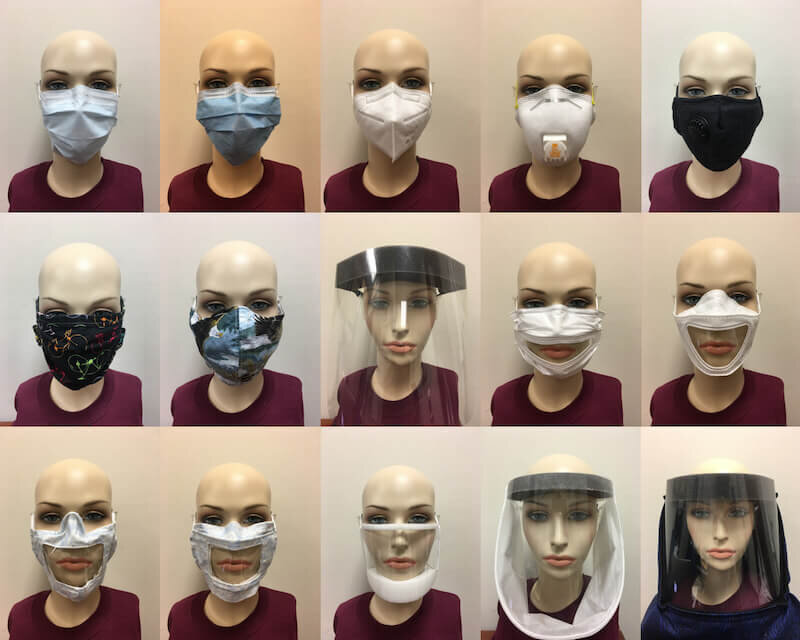By B. Renee McDowell, Morgan Howard, Celeste Watson, M. Bryson Howard, and Samuel R. Atcherson
Since the advent of the COVID-19 pandemic, surgical masks and other face coverings are no longer confined to medical spaces, but have become a common part of the social landscape to slow the spread of viruses.
Many people quickly noticed how difficult it could be to understand others wearing masks and how difficult it can be to speak while wearing them. These difficulties have two primary explanations: First, covering the mouth can muffle the sound quality, often making it less loud. Second, masks generally cover up the mouth and block facial expressions that many people often rely upon. Both of these difficulties are made more challenging in the presence of noise.
While people with hearing loss can struggle in the world of masks, all people are likely affected by masks in many circumstances. Some manufacturers and crafty, do-it-yourself individuals have made masks with a clear (transparent) window made of plastic or vinyl to address this problem. This window allows visual access to the lips and mouth. While nontransparent masks are already a barrier to sound, causing speech to sound muffled, the reflective surface of the window in transparent masks can block sounds, further making speech even more muffled.
Researchers compiled face coverings for the study, including commercial and handmade masks and a variety of partial or full shields. Some of the commercial and handmade masks had clear windows.
What Our Lab Found
Shortly after the pandemic began, we began collecting various types of face coverings (transparent and nontransparent) to study the sound quality using a broad noise presented through a styrofoam mannequin head with a speaker mounted in its mouth. The face coverings compiled included commercial and handmade masks and a variety of partial or full shields. Some of the commercial and handmade masks had clear windows. (See Figure 1.)
Our study, published in The Journal of the Acoustical Society of America in April 2021, found that nontransparent masks had poor sound transmission (filtering) in the higher frequencies (or pitches), but the transparent options were even poorer.
A typical hearing test involves a small range of frequencies that encompasses most sounds of speech, ranging from 250 to 8,000 hertz. Our research showed that most face coverings have a noticeable affect above 1,000 Hz. As a result, the quality of speech is impacted, particularly for sounds such as “S,” “F,” and “T.”
In Figure 2, you can see the difference between the speech spectrograms from a typical surgical mask and a homemade transparent mask. The phrase presented through each mask is “Such windows may be seen in French cathedrals.” There is noticeably more white space for the homemade transparent mask—indicating greater filtering of the higher frequency parts of speech. In other words, the transparent mask likely makes it more difficult to distinctly hear and discern between consonants.
How Can We Fix This?
While our findings about nontransparent face masks were not entirely surprising as they corroborated other earlier research, we were most curious about transparent face coverings. In particular, we wondered how sound transmission and behavior is influenced by the clear windows or shields. Although there is poor sound transmission with transparent masks, we know that many people will benefit from visual access to the mouth and lips. This is a great advantage to their use.
Spectrogram recordings with the sentence “Such windows may be seen in French cathedrals” spoken through the face mask using a speaker mounted in a mannequin head. The top is through a surgical mask, revealing a 3.5 dB reduction in what is heard, and the bottom is through a cloth transparent mask, with a 13.5 dB reduction.
But in terms of sound quality with transparent masks, sounds are being reflected backward from the window and going around the edges. In general, the greater the size of the window, the greater the sound reduction or filtering. The distance between the mouth and the window seems to matter, including overall fit. When the window is large and close to the mouth, it may be more difficult to project one’s voice.
Conversely, when the window is small and farther away from the mouth, it may be easier to project. Full face shields may be a good option as they reveal the entire face. (That said, because they are more open on the sides and bottom, full face shields used alone have been found to be less effective than face masks for blocking virus transmission.)
For those wearing hearing aids, we recommend seeing your audiologist to create a separate program to help compensate for the degraded speech caused by masks. Another solution the audiologist can help with is using a remote microphone system to stream speech to the hearing aid. Ideally the microphone (for any assistive device) is close to the mouth of the speaker in order to better overcome background noise, and reduce speaker fatigue.
While transparent face masks help show facial expressions and facilitate the ability to read lips, they also muffle the sound more than nontransparent face masks. Our lab plans to continue to study the effects of face coverings on communication and how best to remedy any shortcomings.
B. Renee McDowell, Morgan Howard, and Celeste Watson are doctor of audiology students, and M. Bryson Howard, Au.D., and Samuel R. Atcherson, Ph.D. are faculty members, all at the department of audiology and speech pathology at the University of Arkansas for Medical Sciences in Little Rock. Atcherson wrote about transparent face masks in the Winter 2020 issue of Hearing Health magazine.







A practical reference, not a lecture, from a music industry professional on how to protect our first instrument: our hearing.